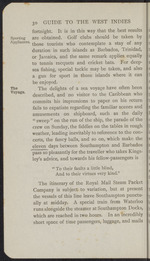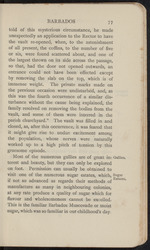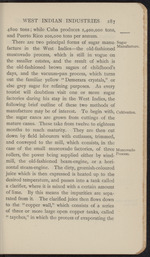| 1 |
 |
“...The taste in regard to beverages in the West
Indies follows very closely that prevailing at home;
but a new-comer should guard against the tendency
to increase the quantity consumed, which must in-
evitably result from a rising thermometer. Light
wines or whisky and soda in moderation are
perhaps the safest “ drinks ” in the tropics; while
for abstainers, lemonade, ginger ale, kola, and
similar concoctions can always be obtained, and
lime squashes will be found infinitely preferable ■
to the familiar lemon squash. Among other bever-
ages peculiar to the West Indies are pimento
dram and falernum, and the old-time sangaree...”
|
|
| 2 |
 |
“...Golf clubs should be taken by
those tourists who contemplate a stay of any
duration in such islands as Barbados, Trinidad,
or Jamaica, and the same remark applies equally
to tennis racquets and cricket bats. For deep-
sea fishing, special tackle may be taken, and also
a gun for sport in those islands where it can
be enjoyed.
The delights of a sea voyage have often been
described, and no visitor to the Caribbean who
commits his impressions to paper on his return
fails to expatiate regarding the familiar scenes and
amusements on shipboard, such as the daily
“ sweep ” on the run of the ship, the parade of the
crew on Sunday, the fiddles on the tables in rough
weather, leading inevitably to reference to the con-
certs, the fancy balls, and so on, which make the
eleven days between Southampton and Barbados
pass so pleasantly for the traveller who takes Kings-
ley’s advice, and towards his fellow-passengers is
“ To their faults a little blind,
And to their virtues very kind.”
The itinerary of the...”
|
|
| 3 |
 |
“...up to a high pitch of tension by this
gruesome episode.
Most of the numerous gullies are of great in- Gullies,
terest and beauty, but they can only be explored
on foot. Permission can usually be obtained to
visit one of the numerous sugar estates, which, Sugar
if not so advanced as regards their methods ofEstates-
manufacture as many in neighbouring colonies,
at any rate produce a quality of sugar which for
flavour and wholesomeness cannot be excelled.
This is the familiar Barbados Muscovado or moist
sugar, which was so familiar in our childhood’s day,...”
|
|
| 4 |
 |
“...be considered rare at home grow in pro-
fusion, and a variety of grasses and lianes hang
from the giant limbs of this monster, which also
affords sanctuary to all sorts of creeping and
crawling things, from the manicou, a kind of
opossum, to the hairy tarantula spider. A clump
of bamboos over 80 feet high cannot fail to
excite remark, and screw-pines (Pandanus), groo-
groo palms (Acrocomia selerocarpa), sand-box trees
(Hura crepitans), cannon-ball trees and banyans,
to say nothing of the more familiar hibiscus,
poinsettias, dracaenas, and crotons of every colour
will astonish those who are new to the tropics.
The gardens contain a well-stocked library and
a fine herbarium, to which visitors interested in
botany are welcomed if they are furnished with...”
|
|
| 5 |
 |
“...WEST INDIAN INDUSTRIES 287
4800 tons; while Cuba produces 1,400,000 tons,
and Puerto Rico 200,000 tons per annum.
There are two principal forms of sugar manu- Sugar
facture in the West Indies—the old-fashionedManufacture-
muscovado process, which is still in vogue on
the smaller estates, and the result of which is
the old-fashioned brown sugars of childhood’s
days, and the vacuum-pan process, which turns
out the familiar yellow “ Demerara crystals,” or
else grey sugar for refining purposes. As every
tourist will doubtless visit one or more sugar
factories during his stay in the West Indies, the
following brief outline of these two methods of
manufacture may be of interest. To begin with, Cultivation,
the sugar canes are grown from cuttings of the
mature canes. These take from twelve to eighteen
months to reach maturity. They are then cut
down by field labourers with cutlasses, trimmed,
and conveyed to the mill, which consists, in the
case of the small muscovado factories, of three Muscovado...”
|
|
| 6 |
 |
“...demand for Jamaica bananas in the
mother country has developed with surprising
rapidity, and a company known as Messrs. Elders
and Fyffes now have no less than thirteen vessels
bringing fruit to England from Jamaica and Costa
Rica as fast as it can be carried.
The Jamaica banana, which is the variety known Varieties of
as the Gros Michel., is cut when the fruit is three- Bananas-
quarters full, and consequently tourists must not
expect to see the fruit growing on the trees in
Jamaica of the familiar yellow colour, but quite
green. In the United States the Jamaica banana
is preferred to the smaller dwarf banana, com-
monly known as the Canary banana (Musa
Cavendishii), which is grown in Barbados, though
the latter is at present more popular in England, |
the reason probably being that the British public
have become accustomed to the fruit from the j
Canary Islands, which had been imported for I
many years before the Jamaica variety was intro-
duced. The two kinds of bananas were existing...”
|
|
